© 2002PearsonEducation, Inc. UpperSaddleRiver,

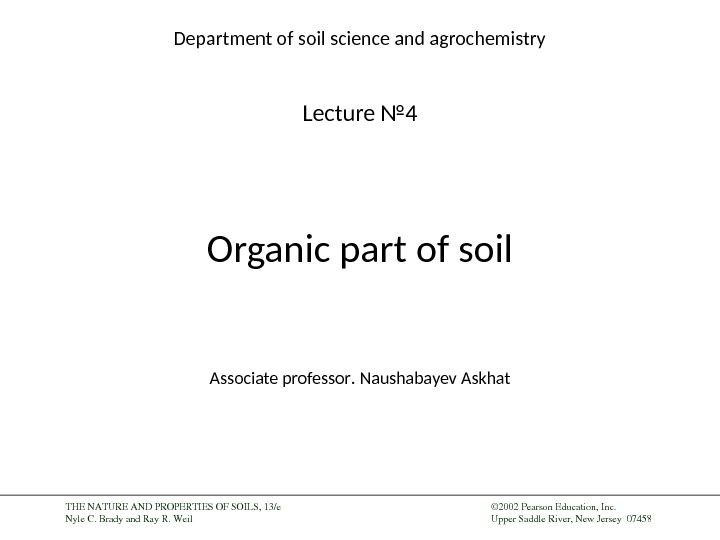
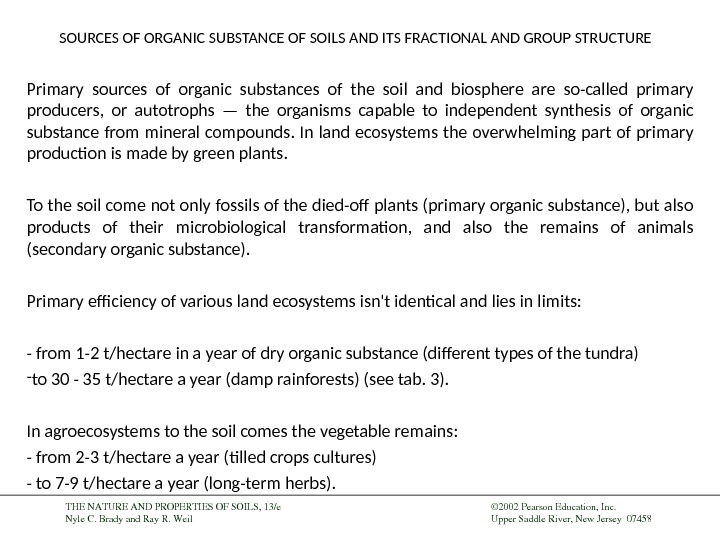



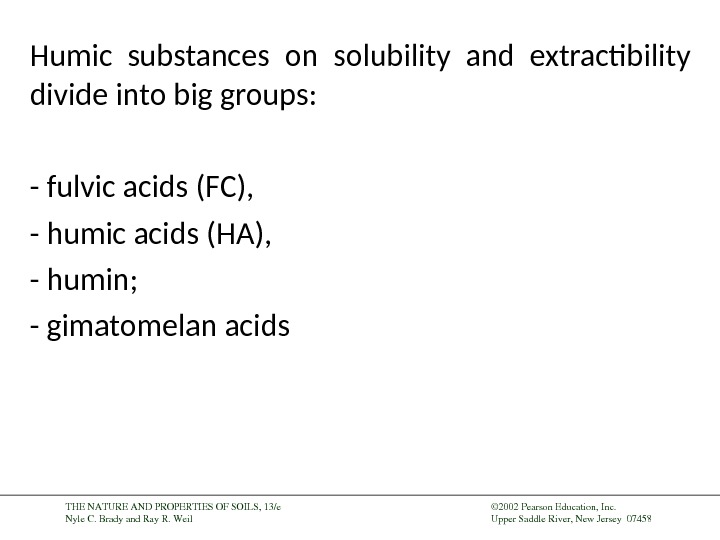


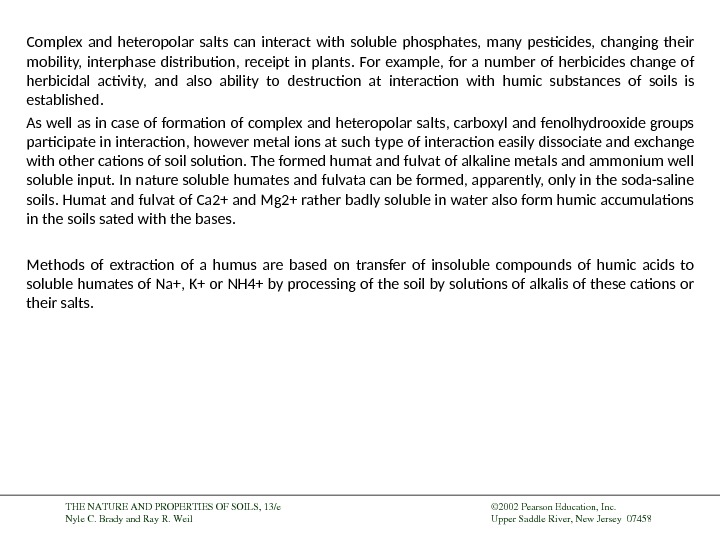











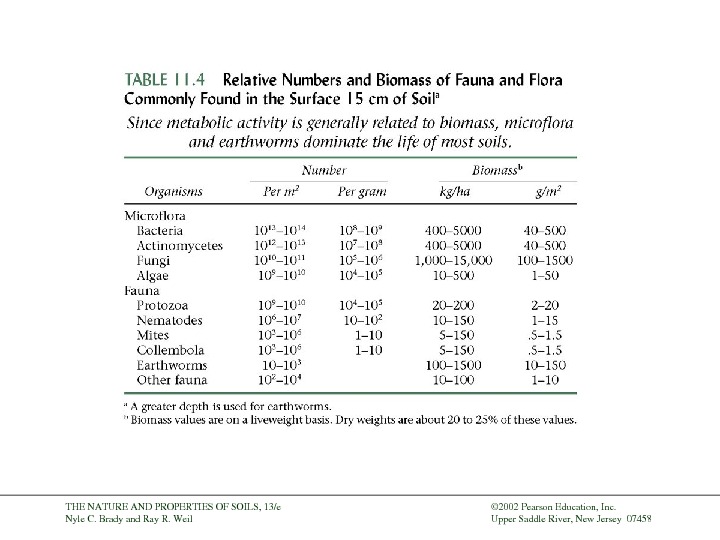














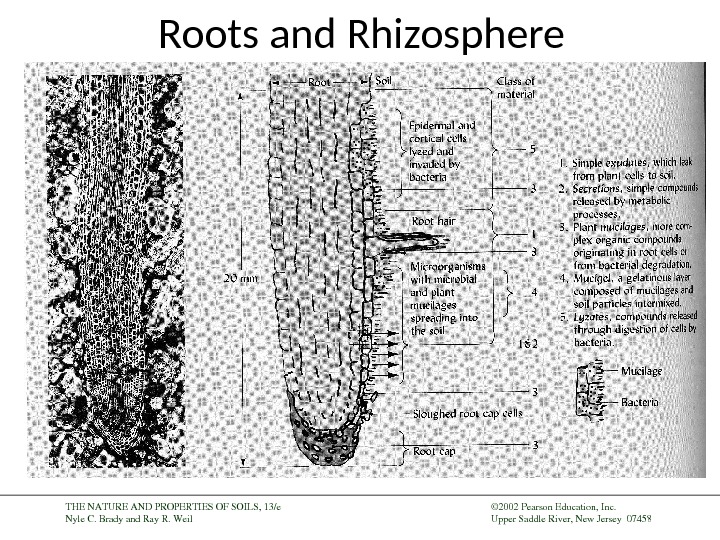
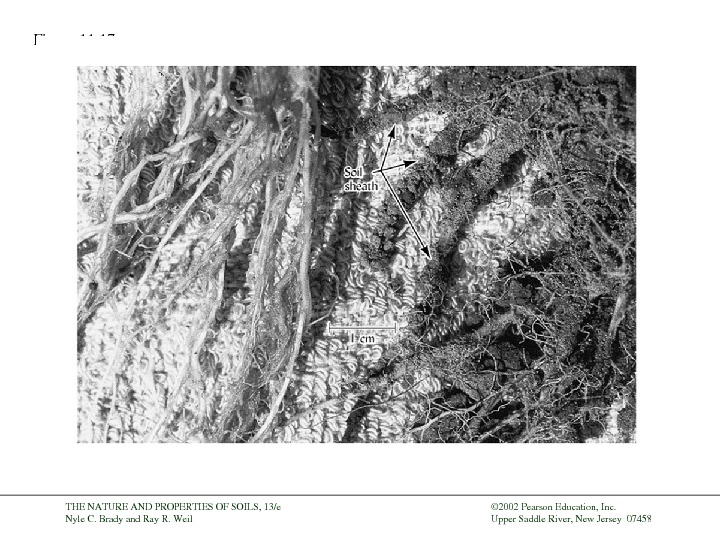















lecture_organic_part_of_soils._humus_composition_and_properties.ppt
- Размер: 7.8 Mегабайта
- Количество слайдов: 52
Описание презентации © 2002PearsonEducation, Inc. UpperSaddleRiver, по слайдам
 © 2002 Pearson. Education, Inc. Upper. Saddle. River, New. Jersey 07458 THENATUREANDPROPERTIESOFSOILS, 13/e Nyle. C. Bradyand. Ray. R. Weil Department of soil science and agrochemistry Lecture № 4 Organic part of soil Associate professor. Naushabayev Askhat
© 2002 Pearson. Education, Inc. Upper. Saddle. River, New. Jersey 07458 THENATUREANDPROPERTIESOFSOILS, 13/e Nyle. C. Bradyand. Ray. R. Weil Department of soil science and agrochemistry Lecture № 4 Organic part of soil Associate professor. Naushabayev Askhat
 © 2002 Pearson. Education, Inc. Upper. Saddle. River, New. Jersey 07458 THENATUREANDPROPERTIESOFSOILS, 13/e Nyle. C. Bradyand. Ray. R. Weil. SOURCES OF ORGANIC SUBSTANCE OF SOILS AND ITS FRACTIONAL AND GROUP STRUCTURE Primary sources of organic substances of the soil and biosphere are so-called primary producers, or autotrophs — the organisms capable to independent synthesis of organic substance from mineral compounds. In land ecosystems the overwhelming part of primary production is made by green plants. To the soil come not only fossils of the died-off plants (primary organic substance), but also products of their microbiological transformation, and also the remains of animals (secondary organic substance). Primary efficiency of various land ecosystems isn’t identical and lies in limits: — from 1 -2 t/hectare in a year of dry organic substance (different types of the tundra) — to 30 — 35 t/hectare a year (damp rainforests) (see tab. 3). In agroecosystems to the soil comes the vegetable remains: — from 2 -3 t/hectare a year (tilled crops cultures) — to 7 -9 t/hectare a year (long-term herbs).
© 2002 Pearson. Education, Inc. Upper. Saddle. River, New. Jersey 07458 THENATUREANDPROPERTIESOFSOILS, 13/e Nyle. C. Bradyand. Ray. R. Weil. SOURCES OF ORGANIC SUBSTANCE OF SOILS AND ITS FRACTIONAL AND GROUP STRUCTURE Primary sources of organic substances of the soil and biosphere are so-called primary producers, or autotrophs — the organisms capable to independent synthesis of organic substance from mineral compounds. In land ecosystems the overwhelming part of primary production is made by green plants. To the soil come not only fossils of the died-off plants (primary organic substance), but also products of their microbiological transformation, and also the remains of animals (secondary organic substance). Primary efficiency of various land ecosystems isn’t identical and lies in limits: — from 1 -2 t/hectare in a year of dry organic substance (different types of the tundra) — to 30 — 35 t/hectare a year (damp rainforests) (see tab. 3). In agroecosystems to the soil comes the vegetable remains: — from 2 -3 t/hectare a year (tilled crops cultures) — to 7 -9 t/hectare a year (long-term herbs).
 © 2002 Pearson. Education, Inc. Upper. Saddle. River, New. Jersey 07458 THENATUREANDPROPERTIESOFSOILS, 13/e Nyle. C. Bradyand. Ray. R. Weil. Receipt of secondary organic substances of a microbiological origin has to be several times below primary efficiency, but can reach units of tons on hectare a year. Receipt of organic substances with the dying-off soil fauna doesn’t exceed in the majority of types of soils 100 -200 kg/hectare a year. In soils of various type nature of distribution of the arriving organic residues on a soil profile isn’t identical. In forest cenosis the main part of primary production arrives with a land waste, while in grassy substantially with the died-off roots. It plays an important role in the subsequent transformation vegetable the remains and soil formation. The chemical composition of the fossils coming to the soil in many respects depends on type of the died-off organisms (table).
© 2002 Pearson. Education, Inc. Upper. Saddle. River, New. Jersey 07458 THENATUREANDPROPERTIESOFSOILS, 13/e Nyle. C. Bradyand. Ray. R. Weil. Receipt of secondary organic substances of a microbiological origin has to be several times below primary efficiency, but can reach units of tons on hectare a year. Receipt of organic substances with the dying-off soil fauna doesn’t exceed in the majority of types of soils 100 -200 kg/hectare a year. In soils of various type nature of distribution of the arriving organic residues on a soil profile isn’t identical. In forest cenosis the main part of primary production arrives with a land waste, while in grassy substantially with the died-off roots. It plays an important role in the subsequent transformation vegetable the remains and soil formation. The chemical composition of the fossils coming to the soil in many respects depends on type of the died-off organisms (table).
 © 2002 Pearson. Education, Inc. Upper. Saddle. River, New. Jersey 07458 THENATUREANDPROPERTIESOFSOILS, 13/e Nyle. C. Bradyand. Ray. R. Weil Table. A chemical composition of the higher and lowest organisms, % to solid (A. E. Vozbutskaya) Organisms Ashes Proteinaceous substances Carbohydrates Lignin Lipids , tannins cellulose Gemicellulose and other carbohydrates Bacteria 2— 10 40— 70 — Есть — 1— 40 Seaweed 20— 30 10— 15 5— 10 50— 60 — 1— 3 Lichens (bushy and lamellar) 2— 6 3 -5 5— 10 60— 80 8— 10 1— 3 Mosses 3— 10 5— 10 15 -25 30— 60 — 5— 10 Filical 6 -7 4 -5 20— 30 20 -30 2— 10 The coniferous: wood 0, 1— 1 0, 5— 1 45— 50 15 -25 25— 30 2— 12 Needles 2— 5 3 -8 15— 20 15 -20 20— 30 15— 20 The deciduous: wood 0, 1— 1 0, 5— 1 40— 50 20— 30 20— 25 5— 15 leaves 3 -8 4— 10 15 -25 10— 20 20— 30 5— 15 Long — term herbs : cereals 5— 10 5— 12 25— 40 25— 35 15— 20 2— 10 bean 5— 10 10— 20 25 -30 15— 25 15— 20 2—
© 2002 Pearson. Education, Inc. Upper. Saddle. River, New. Jersey 07458 THENATUREANDPROPERTIESOFSOILS, 13/e Nyle. C. Bradyand. Ray. R. Weil Table. A chemical composition of the higher and lowest organisms, % to solid (A. E. Vozbutskaya) Organisms Ashes Proteinaceous substances Carbohydrates Lignin Lipids , tannins cellulose Gemicellulose and other carbohydrates Bacteria 2— 10 40— 70 — Есть — 1— 40 Seaweed 20— 30 10— 15 5— 10 50— 60 — 1— 3 Lichens (bushy and lamellar) 2— 6 3 -5 5— 10 60— 80 8— 10 1— 3 Mosses 3— 10 5— 10 15 -25 30— 60 — 5— 10 Filical 6 -7 4 -5 20— 30 20 -30 2— 10 The coniferous: wood 0, 1— 1 0, 5— 1 45— 50 15 -25 25— 30 2— 12 Needles 2— 5 3 -8 15— 20 15 -20 20— 30 15— 20 The deciduous: wood 0, 1— 1 0, 5— 1 40— 50 20— 30 20— 25 5— 15 leaves 3 -8 4— 10 15 -25 10— 20 20— 30 5— 15 Long — term herbs : cereals 5— 10 5— 12 25— 40 25— 35 15— 20 2— 10 bean 5— 10 10— 20 25 -30 15— 25 15— 20 2—
 © 2002 Pearson. Education, Inc. Upper. Saddle. River, New. Jersey 07458 THENATUREANDPROPERTIESOFSOILS, 13/e Nyle. C. Bradyand. Ray. R. Weil. In the majority of types of soils within a soil profile the main part of organic substance is presented by a «dead» reserve of organic compounds. The live biomass (эдафон) consisting of roots, microorganisms, representatives of soil fauna makes about 2 -15% of the general content of organic substance in different soils. Humus — the main part of organic substance of the soil which completely lost lines of an anatomic structure of organisms. Shares on 2 big groups of substances: — nonspecific organic compounds which can be emitted from the soil, are identified and quantitatively defined (sugar, amino acid, a squirrel, the organic bases, tannins, organic acids, etc. ). In the majority of mineral soils make units of percent of the general content of organic substance; — specific humic compounds — the most characteristic specific part making about 80 — 90% of the general content of organic substance in the majority of mineral soils.
© 2002 Pearson. Education, Inc. Upper. Saddle. River, New. Jersey 07458 THENATUREANDPROPERTIESOFSOILS, 13/e Nyle. C. Bradyand. Ray. R. Weil. In the majority of types of soils within a soil profile the main part of organic substance is presented by a «dead» reserve of organic compounds. The live biomass (эдафон) consisting of roots, microorganisms, representatives of soil fauna makes about 2 -15% of the general content of organic substance in different soils. Humus — the main part of organic substance of the soil which completely lost lines of an anatomic structure of organisms. Shares on 2 big groups of substances: — nonspecific organic compounds which can be emitted from the soil, are identified and quantitatively defined (sugar, amino acid, a squirrel, the organic bases, tannins, organic acids, etc. ). In the majority of mineral soils make units of percent of the general content of organic substance; — specific humic compounds — the most characteristic specific part making about 80 — 90% of the general content of organic substance in the majority of mineral soils.
 © 2002 Pearson. Education, Inc. Upper. Saddle. River, New. Jersey 07458 THENATUREANDPROPERTIESOFSOILS, 13/e Nyle. C. Bradyand. Ray. R. Weil. Humic substances on solubility and extractibility divide into big groups: — fulvic acids (FC), — humic acids (HA), — humin; — gimatomelan acids
© 2002 Pearson. Education, Inc. Upper. Saddle. River, New. Jersey 07458 THENATUREANDPROPERTIESOFSOILS, 13/e Nyle. C. Bradyand. Ray. R. Weil. Humic substances on solubility and extractibility divide into big groups: — fulvic acids (FC), — humic acids (HA), — humin; — gimatomelan acids
 © 2002 Pearson. Education, Inc. Upper. Saddle. River, New. Jersey 07458 THENATUREANDPROPERTIESOFSOILS, 13/e Nyle. C. Bradyand. Ray. R. Weil. The element structure of all preparations is various. At the same time all humic acids contain much more carbon less oxygen in comparison with fulvic acids. It testifies to a bigger enrichment of humic acids cyclic fragments while fulvic acids are more oxidized and rather enriched with aliphatic structures. Direct researches of products of destruction of humic acids confirm this situation. Judging by data of the element analysis, are most enriched with carbon, and consequently, and cyclic fragments humic acids of chernozems and sierozems while humic acids of soils of podsolic type according to the content of carbon and oxygen come nearer to fulvic acids a little. The content of nitrogen in all groups of humic substances varies from 2. 5 to 5. 0%. On average humic substances are rather enriched with nitrogen in comparison with the initial vegetable remains. It is connected with that in the course of a mineralization and humification of organic residues carbon is lost in the form of carbon dioxide in much bigger degree, than nitrogen. Explain with existence of carboxyl groups the acid nature of humic substances. Most are enriched by them FA — about 700 — 900 m-eq. on 100 g of air solid, to a lesser extent — group of companies HA— 300 — 400 m-eg. on 100 g of substance.
© 2002 Pearson. Education, Inc. Upper. Saddle. River, New. Jersey 07458 THENATUREANDPROPERTIESOFSOILS, 13/e Nyle. C. Bradyand. Ray. R. Weil. The element structure of all preparations is various. At the same time all humic acids contain much more carbon less oxygen in comparison with fulvic acids. It testifies to a bigger enrichment of humic acids cyclic fragments while fulvic acids are more oxidized and rather enriched with aliphatic structures. Direct researches of products of destruction of humic acids confirm this situation. Judging by data of the element analysis, are most enriched with carbon, and consequently, and cyclic fragments humic acids of chernozems and sierozems while humic acids of soils of podsolic type according to the content of carbon and oxygen come nearer to fulvic acids a little. The content of nitrogen in all groups of humic substances varies from 2. 5 to 5. 0%. On average humic substances are rather enriched with nitrogen in comparison with the initial vegetable remains. It is connected with that in the course of a mineralization and humification of organic residues carbon is lost in the form of carbon dioxide in much bigger degree, than nitrogen. Explain with existence of carboxyl groups the acid nature of humic substances. Most are enriched by them FA — about 700 — 900 m-eq. on 100 g of air solid, to a lesser extent — group of companies HA— 300 — 400 m-eg. on 100 g of substance.
 © 2002 Pearson. Education, Inc. Upper. Saddle. River, New. Jersey 07458 THENATUREANDPROPERTIESOFSOILS, 13/e Nyle. C. Bradyand. Ray. R. Weil. Sorption of humic substances mineral compounds of a solid phase soils can proceed with participation of various mechanisms: an ionic exchange, a hemosorbtion, complex formated sorption, intermitsellyarny (more precisely, intermicelle) absorption of organic substances with not too high molecular weight clay minerals with the inflating crystal lattice. Basic possibility of formation of hydrogen communications and bridges through polyvalent cations at sorption interaction of clay minerals with humic substances is shown. The products of interaction which are formed thus are called sorption complexes, clay-humus complexes, mineral-organic compounds.
© 2002 Pearson. Education, Inc. Upper. Saddle. River, New. Jersey 07458 THENATUREANDPROPERTIESOFSOILS, 13/e Nyle. C. Bradyand. Ray. R. Weil. Sorption of humic substances mineral compounds of a solid phase soils can proceed with participation of various mechanisms: an ionic exchange, a hemosorbtion, complex formated sorption, intermitsellyarny (more precisely, intermicelle) absorption of organic substances with not too high molecular weight clay minerals with the inflating crystal lattice. Basic possibility of formation of hydrogen communications and bridges through polyvalent cations at sorption interaction of clay minerals with humic substances is shown. The products of interaction which are formed thus are called sorption complexes, clay-humus complexes, mineral-organic compounds.
 © 2002 Pearson. Education, Inc. Upper. Saddle. River, New. Jersey 07458 THENATUREANDPROPERTIESOFSOILS, 13/e Nyle. C. Bradyand. Ray. R. Weil. Complex and heteropolar salts can interact with soluble phosphates, many pesticides, changing their mobility, interphase distribution, receipt in plants. For example, for a number of herbicides change of herbicidal activity, and also ability to destruction at interaction with humic substances of soils is established. As well as in case of formation of complex and heteropolar salts, carboxyl and fenolhydrooxide groups participate in interaction, however metal ions at such type of interaction easily dissociate and exchange with other cations of soil solution. The formed humat and fulvat of alkaline metals and ammonium well soluble input. In nature soluble humates and fulvata can be formed, apparently, only in the soda-saline soils. Humat and fulvat of Ca 2+ and Mg 2+ rather badly soluble in water also form humic accumulations in the soils sated with the bases. Methods of extraction of a humus are based on transfer of insoluble compounds of humic acids to soluble humates of Na+, K+ or NH 4+ by processing of the soil by solutions of alkalis of these cations or their salts.
© 2002 Pearson. Education, Inc. Upper. Saddle. River, New. Jersey 07458 THENATUREANDPROPERTIESOFSOILS, 13/e Nyle. C. Bradyand. Ray. R. Weil. Complex and heteropolar salts can interact with soluble phosphates, many pesticides, changing their mobility, interphase distribution, receipt in plants. For example, for a number of herbicides change of herbicidal activity, and also ability to destruction at interaction with humic substances of soils is established. As well as in case of formation of complex and heteropolar salts, carboxyl and fenolhydrooxide groups participate in interaction, however metal ions at such type of interaction easily dissociate and exchange with other cations of soil solution. The formed humat and fulvat of alkaline metals and ammonium well soluble input. In nature soluble humates and fulvata can be formed, apparently, only in the soda-saline soils. Humat and fulvat of Ca 2+ and Mg 2+ rather badly soluble in water also form humic accumulations in the soils sated with the bases. Methods of extraction of a humus are based on transfer of insoluble compounds of humic acids to soluble humates of Na+, K+ or NH 4+ by processing of the soil by solutions of alkalis of these cations or their salts.
 © 2002 Pearson. Education, Inc. Upper. Saddle. River, New. Jersey 07458 THENATUREANDPROPERTIESOFSOILS, 13/e Nyle. C. Bradyand. Ray. R. Weil. ORGANIC SUBSTANCE IN VARIOUS TYPES OF SOILS The organic substance is unequally distributed in profiles of various soils. Over a wide range varies the maintenance of a humus in the top horizons of different soils — from 0. 5 — 1 to 10 — 12% and more. Agricultural use in the conditions of the low standard of farming leads to decrease in level of a humidity. Depending on a ratio of humic to fulvic acids ( S ha: S fa) distinguish the following types of a humus: — humat (>1, 5), — fulvat-humat (1 — 1, 5), — humatno-fulvat (1 — 0, 5) — fulvat (<0, 5). In natural soil formation there is a regularity according to which under optimum conditions of a humus formation the humus which is rather enriched with humic acids (chernozems, humous soils) is formed. Development and an improvement of soils in some cases have usually ambiguous impact and on humus type, changing its qualitative structure. Humus stocks in the separate horizons of soils or a soil profile in general are approximately proportional to the maintenance of a humus in the soil. It is used at comparative — balance estimates. In all soils is held from 25 to 50% of the insoluble rest. This part of a humus is presented by compounds of two types: the semi-decayed vegetable remains of various extent of humification which don't manage to be selected before the analysis, and mineral — humus sorption complexes — the steadiest part of a humus.
© 2002 Pearson. Education, Inc. Upper. Saddle. River, New. Jersey 07458 THENATUREANDPROPERTIESOFSOILS, 13/e Nyle. C. Bradyand. Ray. R. Weil. ORGANIC SUBSTANCE IN VARIOUS TYPES OF SOILS The organic substance is unequally distributed in profiles of various soils. Over a wide range varies the maintenance of a humus in the top horizons of different soils — from 0. 5 — 1 to 10 — 12% and more. Agricultural use in the conditions of the low standard of farming leads to decrease in level of a humidity. Depending on a ratio of humic to fulvic acids ( S ha: S fa) distinguish the following types of a humus: — humat (>1, 5), — fulvat-humat (1 — 1, 5), — humatno-fulvat (1 — 0, 5) — fulvat (<0, 5). In natural soil formation there is a regularity according to which under optimum conditions of a humus formation the humus which is rather enriched with humic acids (chernozems, humous soils) is formed. Development and an improvement of soils in some cases have usually ambiguous impact and on humus type, changing its qualitative structure. Humus stocks in the separate horizons of soils or a soil profile in general are approximately proportional to the maintenance of a humus in the soil. It is used at comparative — balance estimates. In all soils is held from 25 to 50% of the insoluble rest. This part of a humus is presented by compounds of two types: the semi-decayed vegetable remains of various extent of humification which don't manage to be selected before the analysis, and mineral — humus sorption complexes — the steadiest part of a humus.
 © 2002 Pearson. Education, Inc. Upper. Saddle. River, New. Jersey 07458 THENATUREANDPROPERTIESOFSOILS, 13/e Nyle. C. Bradyand. Ray. R. Weil. The fossils coming to the soil are exposed to various biochemical and physical and chemical transformations as a result of which the most part of organic substance is oxidized to the final products, mainly of CO 2, H 2 O and simple salts (mineralization), and smaller, having passed the difficult transformations called in total by hymification joins in structure of specific humic substances of the soil. In the most general view the concept of hymification can be defined as set of biochemical and physical and chemical processes which result is transformation of organic substances of the individual nature into the specific humic substances characterized by some general properties and lines of a structure. These general properties are listed above when determining the concept «humic substances». At such definition of the concept «hymification» and “humus formation» make identical sense. The most important quantitative characteristic of hymification — the coefficient of hymification of Ks representing a share (or percentage part) the carbon of fossils which joined in structure of humic substances at their full decomposition.
© 2002 Pearson. Education, Inc. Upper. Saddle. River, New. Jersey 07458 THENATUREANDPROPERTIESOFSOILS, 13/e Nyle. C. Bradyand. Ray. R. Weil. The fossils coming to the soil are exposed to various biochemical and physical and chemical transformations as a result of which the most part of organic substance is oxidized to the final products, mainly of CO 2, H 2 O and simple salts (mineralization), and smaller, having passed the difficult transformations called in total by hymification joins in structure of specific humic substances of the soil. In the most general view the concept of hymification can be defined as set of biochemical and physical and chemical processes which result is transformation of organic substances of the individual nature into the specific humic substances characterized by some general properties and lines of a structure. These general properties are listed above when determining the concept «humic substances». At such definition of the concept «hymification» and “humus formation» make identical sense. The most important quantitative characteristic of hymification — the coefficient of hymification of Ks representing a share (or percentage part) the carbon of fossils which joined in structure of humic substances at their full decomposition.
 © 2002 Pearson. Education, Inc. Upper. Saddle. River, New. Jersey 07458 THENATUREANDPROPERTIESOFSOILS, 13/e Nyle. C. Bradyand. Ray. R. Weil. A. The functions connected with genesis of the soil, formation of its morphological features, material structure and properties. — Formation specific organic profile. — Aggregate formation with participation humic and the clay-humus of compounds. Interaction of a humus with minerals and formation microbiological and thermodynamic steady structures. — Formation of addition and influence of humic substances on water physical properties of the soil. — Formation labile migration ability of compounds and involvement of mineral components of the soil in biogeochemical circulation. — Formation of sorption, acid and main and buffer properties of the soil. B. The functions connected with direct participation of organic substances in food of plants. — Source of elements of mineral food of the higher plants (N, P, K, Sa, microcells). — A source of organic food for the heterotrophyc of organisms and influence on biological and biochemical activity of soils. — CO 2 source in a ground layer of air and influence on efficiency of photosynthesis. — A source of biologically active agents in the soil having impact on growth and development of plants, mobilization of nutrients etc. (natural growth substances, enzymes, vitamins, etc. ). — Sanitary protection functions of organic substance. — Acceleration of microbiological degradation of pesticides, catalytic influence on the speed of decomposition of pesticides. — Fixing of the polluting substances in soils (sorption, a complex formation etc. ), decrease in receipt of toxicant in a plant. — Strengthening of migratory ability of toxicant.
© 2002 Pearson. Education, Inc. Upper. Saddle. River, New. Jersey 07458 THENATUREANDPROPERTIESOFSOILS, 13/e Nyle. C. Bradyand. Ray. R. Weil. A. The functions connected with genesis of the soil, formation of its morphological features, material structure and properties. — Formation specific organic profile. — Aggregate formation with participation humic and the clay-humus of compounds. Interaction of a humus with minerals and formation microbiological and thermodynamic steady structures. — Formation of addition and influence of humic substances on water physical properties of the soil. — Formation labile migration ability of compounds and involvement of mineral components of the soil in biogeochemical circulation. — Formation of sorption, acid and main and buffer properties of the soil. B. The functions connected with direct participation of organic substances in food of plants. — Source of elements of mineral food of the higher plants (N, P, K, Sa, microcells). — A source of organic food for the heterotrophyc of organisms and influence on biological and biochemical activity of soils. — CO 2 source in a ground layer of air and influence on efficiency of photosynthesis. — A source of biologically active agents in the soil having impact on growth and development of plants, mobilization of nutrients etc. (natural growth substances, enzymes, vitamins, etc. ). — Sanitary protection functions of organic substance. — Acceleration of microbiological degradation of pesticides, catalytic influence on the speed of decomposition of pesticides. — Fixing of the polluting substances in soils (sorption, a complex formation etc. ), decrease in receipt of toxicant in a plant. — Strengthening of migratory ability of toxicant.
 © 2002 Pearson. Education, Inc. Upper. Saddle. River, New. Jersey 07458 THENATUREANDPROPERTIESOFSOILS, 13/e Nyle. C. Bradyand. Ray. R. Weil Organismsand. Ecologyofthe. Soil Headofabacteriafeedingnermatode. (Sven. Bostr öm, Swedish. Museumof. Natural. History)
© 2002 Pearson. Education, Inc. Upper. Saddle. River, New. Jersey 07458 THENATUREANDPROPERTIESOFSOILS, 13/e Nyle. C. Bradyand. Ray. R. Weil Organismsand. Ecologyofthe. Soil Headofabacteriafeedingnermatode. (Sven. Bostr öm, Swedish. Museumof. Natural. History)
 © 2002 Pearson. Education, Inc. Upper. Saddle. River, New. Jersey 07458 THENATUREANDPROPERTIESOFSOILS, 13/e Nyle. C. Bradyand. Ray. R. Weil Diversity of Soil Organisms • Size of Organisms – Macrofauna – Moles, Prairie dogs, earthworms, millipeds – Mesofauna – Springtails and Mites – Microfauna – Nematodes and single-celled protozoans – Flora – Plants Roots – Microorganisms – Fungi, Bacteria, and Actinomycetes
© 2002 Pearson. Education, Inc. Upper. Saddle. River, New. Jersey 07458 THENATUREANDPROPERTIESOFSOILS, 13/e Nyle. C. Bradyand. Ray. R. Weil Diversity of Soil Organisms • Size of Organisms – Macrofauna – Moles, Prairie dogs, earthworms, millipeds – Mesofauna – Springtails and Mites – Microfauna – Nematodes and single-celled protozoans – Flora – Plants Roots – Microorganisms – Fungi, Bacteria, and Actinomycetes
 © 2002 Pearson. Education, Inc. Upper. Saddle. River, New. Jersey 07458 THENATUREANDPROPERTIESOFSOILS, 13/e Nyle. C. Bradyand. Ray. R. Weil Diversity of Soil Organisms • Types of Diversity – Species Diversity – The mix of species present – Functional Diversity – The capacity to use a wide variety of substrates and provide a range of ecosystem services.
© 2002 Pearson. Education, Inc. Upper. Saddle. River, New. Jersey 07458 THENATUREANDPROPERTIESOFSOILS, 13/e Nyle. C. Bradyand. Ray. R. Weil Diversity of Soil Organisms • Types of Diversity – Species Diversity – The mix of species present – Functional Diversity – The capacity to use a wide variety of substrates and provide a range of ecosystem services.
 © 2002 Pearson. Education, Inc. Upper. Saddle. River, New. Jersey 07458 THENATUREANDPROPERTIESOFSOILS, 13/e Nyle. C. Bradyand. Ray. R. Weil Diversity of Soil Organisms • Ecosystem Dynamics – Functional Redundancy – Several organisms can carry out each ecosystem service. • This redundancy leads to ecosystem stability and resilience – Keystone Species – A species that is unique in filling an ecological niche and is therefore integral to the functioning of that system. • Global Biodiversity – Great genetic resource of soil organisms.
© 2002 Pearson. Education, Inc. Upper. Saddle. River, New. Jersey 07458 THENATUREANDPROPERTIESOFSOILS, 13/e Nyle. C. Bradyand. Ray. R. Weil Diversity of Soil Organisms • Ecosystem Dynamics – Functional Redundancy – Several organisms can carry out each ecosystem service. • This redundancy leads to ecosystem stability and resilience – Keystone Species – A species that is unique in filling an ecological niche and is therefore integral to the functioning of that system. • Global Biodiversity – Great genetic resource of soil organisms.
 © 2002 Pearson. Education, Inc. Upper. Saddle. River, New. Jersey 07458 THENATUREANDPROPERTIESOFSOILS, 13/e Nyle. C. Bradyand. Ray. R. Weil
© 2002 Pearson. Education, Inc. Upper. Saddle. River, New. Jersey 07458 THENATUREANDPROPERTIESOFSOILS, 13/e Nyle. C. Bradyand. Ray. R. Weil
 © 2002 Pearson. Education, Inc. Upper. Saddle. River, New. Jersey 07458 THENATUREANDPROPERTIESOFSOILS, 13/e Nyle. C. Bradyand. Ray. R. Weil. Figure 11.
© 2002 Pearson. Education, Inc. Upper. Saddle. River, New. Jersey 07458 THENATUREANDPROPERTIESOFSOILS, 13/e Nyle. C. Bradyand. Ray. R. Weil. Figure 11.
 © 2002 Pearson. Education, Inc. Upper. Saddle. River, New. Jersey 07458 THENATUREANDPROPERTIESOFSOILS, 13/e Nyle. C. Bradyand. Ray. R. Weil. Figure 11.
© 2002 Pearson. Education, Inc. Upper. Saddle. River, New. Jersey 07458 THENATUREANDPROPERTIESOFSOILS, 13/e Nyle. C. Bradyand. Ray. R. Weil. Figure 11.
 © 2002 Pearson. Education, Inc. Upper. Saddle. River, New. Jersey 07458 THENATUREANDPROPERTIESOFSOILS, 13/e Nyle. C. Bradyand. Ray. R. Weil. Figure 11.
© 2002 Pearson. Education, Inc. Upper. Saddle. River, New. Jersey 07458 THENATUREANDPROPERTIESOFSOILS, 13/e Nyle. C. Bradyand. Ray. R. Weil. Figure 11.
 © 2002 Pearson. Education, Inc. Upper. Saddle. River, New. Jersey 07458 THENATUREANDPROPERTIESOFSOILS, 13/e Nyle. C. Bradyand. Ray. R. Weil
© 2002 Pearson. Education, Inc. Upper. Saddle. River, New. Jersey 07458 THENATUREANDPROPERTIESOFSOILS, 13/e Nyle. C. Bradyand. Ray. R. Weil
 © 2002 Pearson. Education, Inc. Upper. Saddle. River, New. Jersey 07458 THENATUREANDPROPERTIESOFSOILS, 13/e Nyle. C. Bradyand. Ray. R. Weil. Figure 11.
© 2002 Pearson. Education, Inc. Upper. Saddle. River, New. Jersey 07458 THENATUREANDPROPERTIESOFSOILS, 13/e Nyle. C. Bradyand. Ray. R. Weil. Figure 11.
 © 2002 Pearson. Education, Inc. Upper. Saddle. River, New. Jersey 07458 THENATUREANDPROPERTIESOFSOILS, 13/e Nyle. C. Bradyand. Ray. R. Weil. Figure 11.
© 2002 Pearson. Education, Inc. Upper. Saddle. River, New. Jersey 07458 THENATUREANDPROPERTIESOFSOILS, 13/e Nyle. C. Bradyand. Ray. R. Weil. Figure 11.
 © 2002 Pearson. Education, Inc. Upper. Saddle. River, New. Jersey 07458 THENATUREANDPROPERTIESOFSOILS, 13/e Nyle. C. Bradyand. Ray. R. Weil Earthworms • Earthworms eat detritus, soil organisms matter, and microorganisms found on these materials. – Probably the most significant macroorganisms in humid temperate region soils – 7000 species worldwide – Epigeic – Live in the litter layer. The compost worm ( Eisenia foetida ) – Endogeic – Live in the top 10 -30 cm of soil. The pale-pink “red worm” ( Allolobophora caliginosa ) – Anecic – Live in vertical burrows up to 1 meter deep. The introduced Night Crawler ( Lumbricus terrestris )
© 2002 Pearson. Education, Inc. Upper. Saddle. River, New. Jersey 07458 THENATUREANDPROPERTIESOFSOILS, 13/e Nyle. C. Bradyand. Ray. R. Weil Earthworms • Earthworms eat detritus, soil organisms matter, and microorganisms found on these materials. – Probably the most significant macroorganisms in humid temperate region soils – 7000 species worldwide – Epigeic – Live in the litter layer. The compost worm ( Eisenia foetida ) – Endogeic – Live in the top 10 -30 cm of soil. The pale-pink “red worm” ( Allolobophora caliginosa ) – Anecic – Live in vertical burrows up to 1 meter deep. The introduced Night Crawler ( Lumbricus terrestris )
 © 2002 Pearson. Education, Inc. Upper. Saddle. River, New. Jersey 07458 THENATUREANDPROPERTIESOFSOILS, 13/e Nyle. C. Bradyand. Ray. R. Weil. Figure 11.
© 2002 Pearson. Education, Inc. Upper. Saddle. River, New. Jersey 07458 THENATUREANDPROPERTIESOFSOILS, 13/e Nyle. C. Bradyand. Ray. R. Weil. Figure 11.
 © 2002 Pearson. Education, Inc. Upper. Saddle. River, New. Jersey 07458 THENATUREANDPROPERTIESOFSOILS, 13/e Nyle. C. Bradyand. Ray. R. Weil Soil Aeration by Earthworms
© 2002 Pearson. Education, Inc. Upper. Saddle. River, New. Jersey 07458 THENATUREANDPROPERTIESOFSOILS, 13/e Nyle. C. Bradyand. Ray. R. Weil Soil Aeration by Earthworms
 © 2002 Pearson. Education, Inc. Upper. Saddle. River, New. Jersey 07458 THENATUREANDPROPERTIESOFSOILS, 13/e Nyle. C. Bradyand. Ray. R. Weil
© 2002 Pearson. Education, Inc. Upper. Saddle. River, New. Jersey 07458 THENATUREANDPROPERTIESOFSOILS, 13/e Nyle. C. Bradyand. Ray. R. Weil
 © 2002 Pearson. Education, Inc. Upper. Saddle. River, New. Jersey 07458 THENATUREANDPROPERTIESOFSOILS, 13/e Nyle. C. Bradyand. Ray. R. Weil. Figure 11.
© 2002 Pearson. Education, Inc. Upper. Saddle. River, New. Jersey 07458 THENATUREANDPROPERTIESOFSOILS, 13/e Nyle. C. Bradyand. Ray. R. Weil. Figure 11.
 © 2002 Pearson. Education, Inc. Upper. Saddle. River, New. Jersey 07458 THENATUREANDPROPERTIESOFSOILS, 13/e Nyle. C. Bradyand. Ray. R. Weil Termite
© 2002 Pearson. Education, Inc. Upper. Saddle. River, New. Jersey 07458 THENATUREANDPROPERTIESOFSOILS, 13/e Nyle. C. Bradyand. Ray. R. Weil Termite
 © 2002 Pearson. Education, Inc. Upper. Saddle. River, New. Jersey 07458 THENATUREANDPROPERTIESOFSOILS, 13/e Nyle. C. Bradyand. Ray. R. Weil. Figure 11.
© 2002 Pearson. Education, Inc. Upper. Saddle. River, New. Jersey 07458 THENATUREANDPROPERTIESOFSOILS, 13/e Nyle. C. Bradyand. Ray. R. Weil. Figure 11.
 © 2002 Pearson. Education, Inc. Upper. Saddle. River, New. Jersey 07458 THENATUREANDPROPERTIESOFSOILS, 13/e Nyle. C. Bradyand. Ray. R. Weil. Figure 11.
© 2002 Pearson. Education, Inc. Upper. Saddle. River, New. Jersey 07458 THENATUREANDPROPERTIESOFSOILS, 13/e Nyle. C. Bradyand. Ray. R. Weil. Figure 11.
 © 2002 Pearson. Education, Inc. Upper. Saddle. River, New. Jersey 07458 THENATUREANDPROPERTIESOFSOILS, 13/e Nyle. C. Bradyand. Ray. R. Weil Nematode
© 2002 Pearson. Education, Inc. Upper. Saddle. River, New. Jersey 07458 THENATUREANDPROPERTIESOFSOILS, 13/e Nyle. C. Bradyand. Ray. R. Weil Nematode
 © 2002 Pearson. Education, Inc. Upper. Saddle. River, New. Jersey 07458 THENATUREANDPROPERTIESOFSOILS, 13/e Nyle. C. Bradyand. Ray. R. Weil. Figure 11. 13 (a) (b)
© 2002 Pearson. Education, Inc. Upper. Saddle. River, New. Jersey 07458 THENATUREANDPROPERTIESOFSOILS, 13/e Nyle. C. Bradyand. Ray. R. Weil. Figure 11. 13 (a) (b)
 © 2002 Pearson. Education, Inc. Upper. Saddle. River, New. Jersey 07458 THENATUREANDPROPERTIESOFSOILS, 13/e Nyle. C. Bradyand. Ray. R. Weil. Figure 11.
© 2002 Pearson. Education, Inc. Upper. Saddle. River, New. Jersey 07458 THENATUREANDPROPERTIESOFSOILS, 13/e Nyle. C. Bradyand. Ray. R. Weil. Figure 11.
 © 2002 Pearson. Education, Inc. Upper. Saddle. River, New. Jersey 07458 THENATUREANDPROPERTIESOFSOILS, 13/e Nyle. C. Bradyand. Ray. R. Weil Two Microanimals Typically Found in Soils Ciliatedprotozoan Twospeciesofrotifer
© 2002 Pearson. Education, Inc. Upper. Saddle. River, New. Jersey 07458 THENATUREANDPROPERTIESOFSOILS, 13/e Nyle. C. Bradyand. Ray. R. Weil Two Microanimals Typically Found in Soils Ciliatedprotozoan Twospeciesofrotifer
 © 2002 Pearson. Education, Inc. Upper. Saddle. River, New. Jersey 07458 THENATUREANDPROPERTIESOFSOILS, 13/e Nyle. C. Bradyand. Ray. R. Weil Roots and Rhizosphere
© 2002 Pearson. Education, Inc. Upper. Saddle. River, New. Jersey 07458 THENATUREANDPROPERTIESOFSOILS, 13/e Nyle. C. Bradyand. Ray. R. Weil Roots and Rhizosphere
 © 2002 Pearson. Education, Inc. Upper. Saddle. River, New. Jersey 07458 THENATUREANDPROPERTIESOFSOILS, 13/e Nyle. C. Bradyand. Ray. R. Weil. Figure 11.
© 2002 Pearson. Education, Inc. Upper. Saddle. River, New. Jersey 07458 THENATUREANDPROPERTIESOFSOILS, 13/e Nyle. C. Bradyand. Ray. R. Weil. Figure 11.
 © 2002 Pearson. Education, Inc. Upper. Saddle. River, New. Jersey 07458 THENATUREANDPROPERTIESOFSOILS, 13/e Nyle. C. Bradyand. Ray. R. Weil. Figure 11.
© 2002 Pearson. Education, Inc. Upper. Saddle. River, New. Jersey 07458 THENATUREANDPROPERTIESOFSOILS, 13/e Nyle. C. Bradyand. Ray. R. Weil. Figure 11.
 © 2002 Pearson. Education, Inc. Upper. Saddle. River, New. Jersey 07458 THENATUREANDPROPERTIESOFSOILS, 13/e Nyle. C. Bradyand. Ray. R. Weil. Figure 11.
© 2002 Pearson. Education, Inc. Upper. Saddle. River, New. Jersey 07458 THENATUREANDPROPERTIESOFSOILS, 13/e Nyle. C. Bradyand. Ray. R. Weil. Figure 11.
 © 2002 Pearson. Education, Inc. Upper. Saddle. River, New. Jersey 07458 THENATUREANDPROPERTIESOFSOILS, 13/e Nyle. C. Bradyand. Ray. R. Weil. Figure 11.
© 2002 Pearson. Education, Inc. Upper. Saddle. River, New. Jersey 07458 THENATUREANDPROPERTIESOFSOILS, 13/e Nyle. C. Bradyand. Ray. R. Weil. Figure 11.
 © 2002 Pearson. Education, Inc. Upper. Saddle. River, New. Jersey 07458 THENATUREANDPROPERTIESOFSOILS, 13/e Nyle. C. Bradyand. Ray. R. Weil. Figure 11. 21 (a) (b)
© 2002 Pearson. Education, Inc. Upper. Saddle. River, New. Jersey 07458 THENATUREANDPROPERTIESOFSOILS, 13/e Nyle. C. Bradyand. Ray. R. Weil. Figure 11. 21 (a) (b)
 © 2002 Pearson. Education, Inc. Upper. Saddle. River, New. Jersey 07458 THENATUREANDPROPERTIESOFSOILS, 13/e Nyle. C. Bradyand. Ray. R. Weil. Figure 11.
© 2002 Pearson. Education, Inc. Upper. Saddle. River, New. Jersey 07458 THENATUREANDPROPERTIESOFSOILS, 13/e Nyle. C. Bradyand. Ray. R. Weil. Figure 11.
 © 2002 Pearson. Education, Inc. Upper. Saddle. River, New. Jersey 07458 THENATUREANDPROPERTIESOFSOILS, 13/e Nyle. C. Bradyand. Ray. R. Weil. Figure 11.
© 2002 Pearson. Education, Inc. Upper. Saddle. River, New. Jersey 07458 THENATUREANDPROPERTIESOFSOILS, 13/e Nyle. C. Bradyand. Ray. R. Weil. Figure 11.
 © 2002 Pearson. Education, Inc. Upper. Saddle. River, New. Jersey 07458 THENATUREANDPROPERTIESOFSOILS, 13/e Nyle. C. Bradyand. Ray. R. Weil The Effect of Phosphorous and Mycorrhizae Treatments
© 2002 Pearson. Education, Inc. Upper. Saddle. River, New. Jersey 07458 THENATUREANDPROPERTIESOFSOILS, 13/e Nyle. C. Bradyand. Ray. R. Weil The Effect of Phosphorous and Mycorrhizae Treatments
 © 2002 Pearson. Education, Inc. Upper. Saddle. River, New. Jersey 07458 THENATUREANDPROPERTIESOFSOILS, 13/e Nyle. C. Bradyand. Ray. R. Weil. Figure 11.
© 2002 Pearson. Education, Inc. Upper. Saddle. River, New. Jersey 07458 THENATUREANDPROPERTIESOFSOILS, 13/e Nyle. C. Bradyand. Ray. R. Weil. Figure 11.
 © 2002 Pearson. Education, Inc. Upper. Saddle. River, New. Jersey 07458 THENATUREANDPROPERTIESOFSOILS, 13/e Nyle. C. Bradyand. Ray. R. Weil Fungi, Bacteria, and Actinomycetes Fungal. Hyphaeandrodshapedbacteria Actinomycetethreads
© 2002 Pearson. Education, Inc. Upper. Saddle. River, New. Jersey 07458 THENATUREANDPROPERTIESOFSOILS, 13/e Nyle. C. Bradyand. Ray. R. Weil Fungi, Bacteria, and Actinomycetes Fungal. Hyphaeandrodshapedbacteria Actinomycetethreads
 © 2002 Pearson. Education, Inc. Upper. Saddle. River, New. Jersey 07458 THENATUREANDPROPERTIESOFSOILS, 13/e Nyle. C. Bradyand. Ray. R. Weil. Figure 11.
© 2002 Pearson. Education, Inc. Upper. Saddle. River, New. Jersey 07458 THENATUREANDPROPERTIESOFSOILS, 13/e Nyle. C. Bradyand. Ray. R. Weil. Figure 11.
 © 2002 Pearson. Education, Inc. Upper. Saddle. River, New. Jersey 07458 THENATUREANDPROPERTIESOFSOILS, 13/e Nyle. C. Bradyand. Ray. R. Weil. Figure 11.
© 2002 Pearson. Education, Inc. Upper. Saddle. River, New. Jersey 07458 THENATUREANDPROPERTIESOFSOILS, 13/e Nyle. C. Bradyand. Ray. R. Weil. Figure 11.
 © 2002 Pearson. Education, Inc. Upper. Saddle. River, New. Jersey 07458 THENATUREANDPROPERTIESOFSOILS, 13/e Nyle. C. Bradyand. Ray. R. Weil
© 2002 Pearson. Education, Inc. Upper. Saddle. River, New. Jersey 07458 THENATUREANDPROPERTIESOFSOILS, 13/e Nyle. C. Bradyand. Ray. R. Weil
 © 2002 Pearson. Education, Inc. Upper. Saddle. River, New. Jersey 07458 THENATUREANDPROPERTIESOFSOILS, 13/e Nyle. C. Bradyand. Ray. R. Weil
© 2002 Pearson. Education, Inc. Upper. Saddle. River, New. Jersey 07458 THENATUREANDPROPERTIESOFSOILS, 13/e Nyle. C. Bradyand. Ray. R. Weil
 © 2002 Pearson. Education, Inc. Upper. Saddle. River, New. Jersey 07458 THENATUREANDPROPERTIESOFSOILS, 13/e Nyle. C. Bradyand. Ray. R. Weil
© 2002 Pearson. Education, Inc. Upper. Saddle. River, New. Jersey 07458 THENATUREANDPROPERTIESOFSOILS, 13/e Nyle. C. Bradyand. Ray. R. Weil
 © 2002 Pearson. Education, Inc. Upper. Saddle. River, New. Jersey 07458 THENATUREANDPROPERTIESOFSOILS, 13/e Nyle. C. Bradyand. Ray. R. Weil
© 2002 Pearson. Education, Inc. Upper. Saddle. River, New. Jersey 07458 THENATUREANDPROPERTIESOFSOILS, 13/e Nyle. C. Bradyand. Ray. R. Weil

